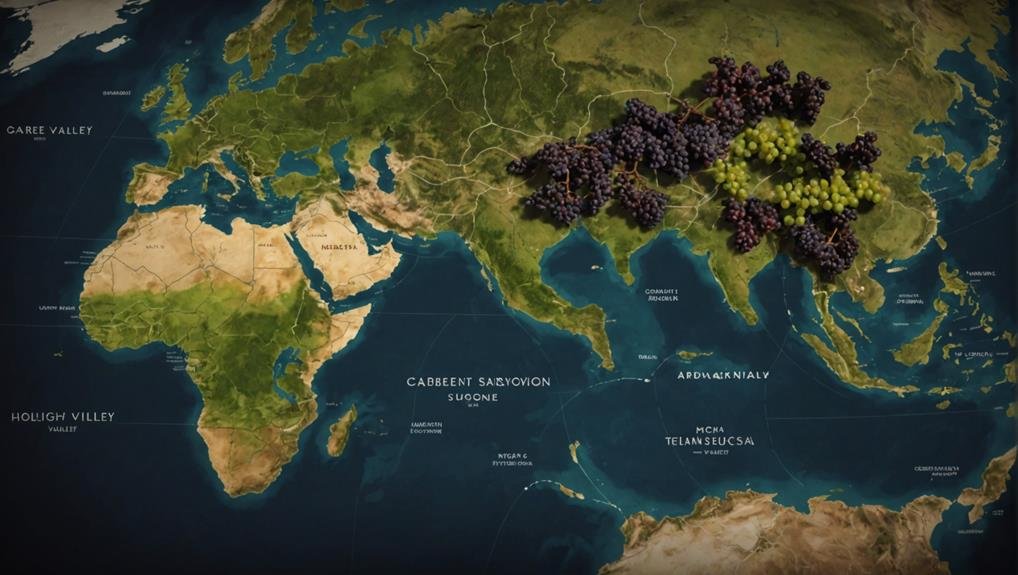Cabernet Sauvignon is a renowned wine with a rich history and significant influence in the wine world. The process of crafting this noble grape into a fine wine involves meticulous care and dedication.
By exploring the complexities of Cabernet Sauvignon, a range of flavors and aromas are unveiled, showcasing its true charm. Join us on a journey through the vineyards and cellars where Cabernet Sauvignon shines, leaving a mark on the wine industry with its prestigious reputation and unmatched character.
Cabernet Sauvignon's Global Dominance

Cabernet Sauvignon is widely recognized as the most popular and esteemed red wine grape globally, with around 720,000 acres dedicated to its cultivation. Alongside Merlot, this grape variety holds a prominent position in vineyards worldwide. Research by Kym Anderson's team at the University of Adelaide has confirmed the top status of these grapes.
From Bordeaux to Napa Valley, the demand for Cabernet Sauvignon grapes remains consistently high, leading to premium pricing and significant economic impact. This versatile grape is a key component in famous wine blends like Bordeaux, Meritage, and Supertuscan, showcasing its desirability in the wine industry.
As a cornerstone of the wine world, Cabernet Sauvignon continues to captivate wine connoisseurs and enthusiasts with its unparalleled presence and influence.
Aromatic Complexity and Flavor Influence
Cabernet Sauvignon stands out in the wine world for its complex flavor profile, which is attributed to various aromatic compounds. One such compound, Methoxypyrazine, is responsible for lending unique characteristics to this renowned wine. Methoxypyrazine introduces aromas of black pepper and green peppercorn, adding depth and richness to the overall taste. The levels of Methoxypyrazine present in the wine can significantly impact its flavor, making it a crucial element in defining Cabernet Sauvignon's profile.
Moreover, the presence of pyrazine in this grape variety has prompted vineyard experts to adjust their cultivation techniques to enhance these desirable aromas. These aromatic compounds play a vital role in shaping the distinctive flavor profile of Cabernet Sauvignon, solidifying its status as a standout in the world of wines.
Familial Connections and Taste Profiles

Genetic connections tie Cabernet Sauvignon to other grape varieties, influencing the distinct taste profiles of these wines. One notable relationship is with Merlot, as Cabernet Sauvignon is a half-sibling of this grape, resulting in shared characteristics and flavors.
Additionally, similarities with Carménère and genetic ties to Hondarribi Beltza also impact the taste of Cabernet Sauvignon wines, showcasing familial connections that contribute to their unique profiles.
The relatedness among these grape varieties plays a significant role in shaping the flavor diversity of Cabernet Sauvignon wines, offering a range of tastes for wine enthusiasts to explore and enjoy.
Versatility in Wine Blending
Genetic connections between grape varieties not only influence the flavor profiles of wines but also play a crucial role in their versatility for blending. Cabernet Sauvignon's knack for harmonizing with other varietals leads to a wide range of unique wine blends cherished globally.
Check out some popular blends featuring Cabernet Sauvignon:
- Bordeaux Blend: A mix of Cabernet Sauvignon, Merlot, Cabernet Franc, and Petit Verdot.
- Meritage: Combining Cabernet Sauvignon, Merlot, Cabernet Franc, and Petit Verdot.
- Supertuscan: Blending Cabernet Sauvignon, Sangiovese, and Merlot.
- CMS Blend: A fusion of Cabernet Sauvignon, Merlot, and Syrah.
These blends showcase the adaptability of Cabernet Sauvignon and its pivotal role in crafting diverse and flavorful wines across various regions.
Economic Impact in Napa Valley

In the heart of Napa Valley, Cabernet Sauvignon grapes hold significant economic value, commanding high prices and meeting a strong demand from wineries. This economic influence extends beyond local businesses to impact global markets.
- Premium Pricing: Wineries are willing to pay a premium for Cabernet Sauvignon grapes due to their exceptional quality and esteemed reputation.
- High Demand: The popularity and desirability of Cabernet grapes in Napa Valley result in a steady and robust demand from consumers and winemakers alike.
- Economic Contribution: The cultivation and sale of Cabernet Sauvignon grapes play a vital role in driving the economic prosperity of Napa Valley, supporting livelihoods and businesses in the region.
- Global Market Impact: Napa Valley's production of Cabernet Sauvignon grapes influences the global wine market, setting trends and influencing pricing strategies across the industry.
Investment Potential and Market Trends
When it comes to wine economics, Cabernet Sauvignon stands out as a fascinating option for investment analysis and market observation. Unlike traditional investments, Cabernet Sauvignon wines are treated like commodities, with platforms such as Liv-ex and Cavex keeping track of their market values.
Investors often liken wine investments to assets like gold or jewelry, and the Bordeaux region is particularly renowned for its potential in this regard. By monitoring wine trading platforms, investors can gain valuable insights into market trends and seize opportunities to diversify their investment portfolios.
The allure of Cabernet Sauvignon goes beyond its taste; it has become a sought-after option for investors looking to capitalize on the thriving wine market. To make the most of this growing demand, understanding market dynamics and investment potentials is crucial for investors in the wine industry.
International Influence and Popularity

The widespread popularity of Cabernet Sauvignon in the wine industry can be attributed to its global appeal and enduring charm in various international markets.
- Rising Demand in China: Cabernet Sauvignon is a top choice in China's red wine market, where the country holds the title of the largest consumer of red wine worldwide.
- Chile's Bordeaux-Style Wines: Chilean wineries craft Bordeaux-style wines featuring Cabernet Sauvignon as a prominent element, attracting investments from prestigious French chateaus.
- French Influence on Chilean Wines: France's recognition of Chile's potential for cultivating Cabernet Sauvignon has spurred significant investments and labeling practices akin to Bordeaux wines.
- Wine Spectator's Preference: Cabernet Sauvignon leads as the most extensively reviewed red wine variety in Wine Spectator's vast collection, with nearly 24,000 tasting notes dedicated to its diverse array of wines.
Frequently Asked Questions
How Do Vineyard Practices in China Differ From Traditional Methods for Cabernet Sauvignon?
In China, vineyard practices for Cabernet Sauvignon are tailored to the region's climate and soil, incorporating unique cultivation techniques. These practices combine traditional and modern approaches to enhance grape quality, reflecting the diversity and innovation in Chinese winemaking. By adapting to local conditions and embracing new methods, Chinese vineyards strive to optimize the growth and development of Cabernet Sauvignon grapes, contributing to the evolution of the country's wine industry.
What Sets Apart Bordeaux-Style Wines Produced in Chile From Those in Bordeaux Itself?
When comparing Bordeaux-style wines from Chile to those from Bordeaux, we can see how the terroir influences grape characteristics and adds complexity to the wines. Chile's geography and climate play a crucial role in shaping the unique flavors found in their wines, setting them apart from their French counterparts. This distinction highlights the impact of terroir on the final product, showcasing the diversity and richness that different regions can bring to winemaking.
Are There Any Unique Blends Worldwide That Prominently Feature Cabernet Sauvignon?
Cabernet Sauvignon plays a significant role in various renowned blends worldwide, such as Bordeaux, Meritage, Supertuscan, and CMS blends. These blends highlight the adaptability and popularity of Cabernet Sauvignon in diverse wine regions, adding unique flavors and characteristics to the wines.
What Makes the Taste Profiles of Cabernet Sauvignon and Its Half-Siblings Distinct?
The unique taste profiles of Cabernet Sauvignon and its half-siblings come from their shared genetic heritage, which influences the flavors they develop. The saying 'like mother, like daughter' often used in the wine industry perfectly illustrates how the genetic connections between these grape varieties shape their distinct taste characteristics.
How Do Cabernet Sauvignon Wines From Napa Valley Compare to Those From Other Regions in Terms of Price and Quality?
Napa Valley's Cabernet Sauvignon wines are highly sought after and command premium prices due to their popularity, despite being the most widely planted grape in the region. The area is well-known for producing top-quality wines, leading wineries to pay a premium for these grapes. This not only highlights the economic significance of the industry but also underscores the exceptional quality of the wines produced in Napa Valley.
Conclusion
Cabernet Sauvignon is undeniably one of the most popular grape varieties globally, with about 720,000 acres dedicated to its cultivation worldwide. Interestingly, it holds the title of being the most widely planted grape variety globally, highlighting its immense popularity and significance in the wine industry.
This grape is cherished for its intricate flavor profile, versatility in blending, and substantial economic impact, making it a true favorite among both wine enthusiasts and producers worldwide.